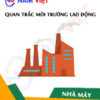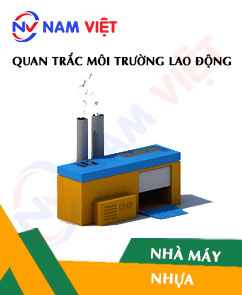Occupational environment monitoring at the electrical equipment factory
99,000 ₫
Note: The above price is calculated for one sample, the price may vary depending on the area of the environment that needs monitoring and the movement of the market. For more accurate price support, please refer to the quotation table or contact directly with our consulting staff.
Environmental monitoring of an electrical equipment factory is a session of collecting, analyzing, and evaluating factors in the workplace that may harm workers health.
Table of Contents
Toggle1. Overview of the electrical equipment factory
a. What is an electrical equipment factory?
Factory producing electrical equipment is a manufacturing facility specialized in producing electrical devices used in electrical systems, including electronic components and parts, switches, converters, transformers, generators, electrical boxes, lighting devices, and many other products related to the electrical industry.
This factory can manufacture products ranging from small items such as electronic components for household electrical devices to larger equipment such as transformers or high-capacity generators used in industrial, commercial, or residential applications.

b. Production stages in the electrical equipment factory
The production stages in an electrical equipment factory may include the following phases:
- Design and research: This is the initial stage to develop designs and ideas for new electrical devices. Technology research, simulation, and testing are conducted to ensure product feasibility and efficiency.
- Component manufacturing: Electronic components, such as capacitors, diodes, resistors, transistors, and microchips, are manufactured during this stage. Component manufacturing may include metal processing, material feeding, assembly, and quality inspection.
- Assembly and system setup: Components are assembled into electrical devices such as switches, converters, transformers, generators, and other electronic equipment. These stages may include mechanical assembly, electronic assembly, wiring, and system configuration.
- Inspection and quality control: Electrical devices are inspected for quality and compliance with standards and regulations. Inspections may include functionality testing, safety testing, voltage testing, and durability testing.
- Packing and transportation: After inspection and quality control, electrical devices are packaged for protection and shipped to the final usage location.

c. Types of machinery used in the electrical equipment factory
In an electrical equipment factory, many types of machines and equipment are used to perform production processes. Below are some common types of machinery in the electrical equipment industry:
- Punching machine: Used to cut and press metal sheets into desired shapes and sizes.
- Lathe machine: Used to process metal by rotating and cutting away excess material.
- Milling machine: Used to process metal by moving the milling cutter to create complex shapes and structures on metal surfaces.
- Planer machine: Used to create flat and smooth surfaces on metal parts.
- Welding machine: Used to weld metal parts together or weld electrical wires.
- Plastic injection machine: Used to mold plastic components into desired shapes and sizes.
- Air compressor: Used to supply compressed air to equipment and tools during production.
- Quality inspection machine: Used to inspect electrical devices after production, including functionality testing, voltage measurement, performance measurement, and safety testing.
- Printing and embossing machine: Used to print and emboss labels, barcodes, or product information onto the surface of electrical devices.
- Packing machine: Used to package and wrap electrical devices into units or final packaging before transportation.

d. What occupational diseases may workers in electrical equipment factories face?
Workers in electrical equipment factories may be exposed to several factors that can cause occupational diseases. Below are some common occupational diseases that workers in the electrical equipment industry may encounter:
- Respiratory diseases: Workers may be exposed to metal dust, chemical fumes, or toxic gases during processing and welding of electronic components, leading to respiratory issues such as pneumonia, asthma, sinusitis, bronchitis, and other problems.
- Skin diseases: Exposure to chemicals, solvents, or oils during production may cause skin irritation, dermatitis, folliculitis, eczema, contact dermatitis, and other skin problems.
- Spinal and musculoskeletal diseases: Working in unfavorable environments, such as improper posture, lifting, and transporting heavy loads, may cause spinal problems, joint pain, headaches, back pain, and cervical spine issues.
- Vision-related diseases: Using tools, machines, and equipment during production may cause eye strain, dry eyes, tearing, and other vision-related issues.
- Noise-related diseases: Using machines and equipment that generate high noise levels during production may cause hearing problems, which can lead to tinnitus, hearing loss, and other auditory issues.
- Electromagnetic-related diseases: Exposure to electrical devices may cause problems related to electromagnetic impact, including electric shock, electrical burns, and other safety issues.

e. Common types of electrical equipment on the market
There are many types of electrical equipment commonly available on the market. Below are some common electrical devices you may find in houses, offices, and construction projects:
- Lighting devices: Including compact lamps, incandescent bulbs, LED lamps, fluorescent lamps, decorative lamps, street lights, floodlights, halogen lamps, and many other types.
- Fans and air conditioners: Including wall fans, ceiling fans, table fans, air coolers, air purifiers, and many types of air conditioners.
- Household appliances: Including refrigerators, washing machines, dryers, water purifiers, electric stoves, vacuum cleaners, air coolers, and many other household devices.
- Electronic devices: Including computers, printers, scanners, game consoles, mobile phones, music players, televisions, disc players, HD players, and many other electronic devices.
- Security devices: Including surveillance cameras, alarm systems, fire protection systems, access control systems, and other security devices.
- Industrial electrical equipment: Including electric motors, air compressors, welding machines, generators, PLC controllers, measuring instruments, and many other industrial electrical devices.
2. Overview of occupational environment monitoring services
a. What is occupational environment monitoring in electrical equipment factories?
Occupational environment monitoring (or workplace environment measurement) in electrical equipment factories is the activity of collecting, evaluating, and analyzing measurement indicators of workplace environmental factors at electrical equipment factories, in order to take timely measures to minimize environmental impacts on workers’ health and prevent occupational diseases. Occupational environment monitoring is a mandatory requirement for electrical equipment factories.
Occupational environment monitoring plays the most important role in taking care of, protecting, and improving workers’ health because workers are the main resource of enterprises and directly generate profits. Workers frequently exposed to risk factors and occupational hazards exceeding permissible standards will suffer health impacts and occupational diseases.
REGISTER FOR OCCUPATIONAL ENVIRONMENT MONITORING SERVICE
b. Occupational environment monitoring program of Nam Viet
The occupational environment monitoring program of Nam Viet is a program researched by monitoring engineers in the field of occupational safety and environmental protection. With the goal of ensuring workers’ health and safety, this program uses modern measurement methods to monitor air quality, water, microclimate, physical factors, and dust in the workplace environment. This is a very important program to ensure a safe working environment and protect workers’ health.
In addition, Nam Viet’s occupational environment monitoring program also plays an important role in researching and developing new solutions to improve workplace environmental quality. With the dedication and professionalism of its monitoring experts, Nam Viet’s exclusive monitoring program is becoming a breakthrough in occupational safety management and environmental protection in Vietnam.

c. Standardization in workplace environment measurement procedures
Standardization in workplace environment measurement procedures of Nam Viet is a very important aspect in ensuring the quality of measurement results. To ensure accuracy and reliability of results, this program applies recognized standards and standardized procedures of the Ho Chi Minh City Department of Health. This ensures that collected data is highly reliable for workplace environmental evaluation and making decisions on workplace improvements to protect workers’ health.
These standardized procedures also ensure that measurement results are carried out by a team of monitoring specialists with high qualifications and many years of experience, allowing managers and experts to trust the results from An Toan Nam Viet and make accurate, valuable decisions in protecting workers’ health and the environment.
By applying standardization in workplace environment measurement procedures, Nam Viet demonstrates its commitment to ensuring a safe working environment and protecting workers’ health, while also contributing positively to the development and improvement of occupational safety management and environmental protection quality in Vietnam.
d. Monitoring report results of the electrical equipment factory
The occupational environment monitoring results are prepared according to form No. 04, Appendix III issued with Decree 44/2016/ND-CP and are made in 02 copies: 01 copy sent to the workplace that signed a contract for occupational environment monitoring and 01 copy stored at the monitoring organization.
The storage period for occupational environment monitoring results is indefinite as prescribed by law.

e. Frequency of occupational environment monitoring according to legal regulations
According to Clause 2 of Article 18 of the Law on Occupational Safety and Hygiene 84/2015/QH13, employers must organize occupational environment monitoring to assess harmful factors at least once a year.
f. Deadline for submitting occupational environment monitoring results according to legal regulations
The deadline for submission is before December 31 every year. Enterprises in production facilities are required to submit occupational environment monitoring results to the Department of Health at the locality where their head office and employees are located.
When there are changes in technology processes, production processes, or when renovating or upgrading workplaces with risks of new harmful factors affecting workers’ health, enterprises in production facilities must update occupational hygiene records regarding harmful factors requiring occupational environment monitoring.
g. Penalties for violations of occupational environment monitoring regulations for employers
According to Article 27 of Decree No. 12/2022/ND-CP dated January 17, 2022, on administrative penalties in the field of labor, social insurance, and Vietnamese workers working abroad under contracts:
- Clause 2: A fine of 2,000,000 – 5,000,000 VND for employers who fail to publicly announce to employees at the workplace monitoring site and at inspected, evaluated, and managed hazardous factor areas immediately after obtaining occupational environment monitoring results and hazard management results at the workplace.
- Clause 3: A fine of 20,000,000 – 40,000,000 VND for employers who fail to conduct occupational environment monitoring to control impacts on workers’ health as prescribed by law.
- Clause 4: A fine of 40,000,000 – 60,000,000 VND for employers who collude with monitoring organizations to commit fraud in occupational environment monitoring activities but not to the extent of criminal prosecution.
3. Harmful environmental factors for workers in the electrical equipment factory
There are several environmental factors that may be harmful to workers in the electrical equipment factory. Below are some major environmental factors that may pose risks to workers’ health in the electrical equipment manufacturing industry:
- Noise: Excessive noise from machinery and production processes may negatively affect workers, causing insomnia, stress, and possible hearing damage.
- Dust and particles: The process of machining and manufacturing electrical components may generate dust and fine particles. Long-term inhalation of this dust and particles may cause pneumonia, respiratory problems, and other health issues.
- Chemicals: The processes of using and handling chemicals in electrical equipment production may generate chemical waste and fumes. Exposure to hazardous chemicals may cause skin irritation, respiratory problems, and potential damage to internal organs.
- High voltage and electrical hazards: During the production of electrical equipment, workers may be exposed to high voltage and other electrical hazards. Electrical accidents such as electric shock and explosions may occur if safety measures are not followed.
- Temperature and humidity: The working environment in the electrical equipment factory may have high temperature and humidity, especially in areas near heavily operating machinery. These environmental conditions may cause physical difficulties such as exhaustion, fatigue, and dehydration.
REGISTER FOR OCCUPATIONAL ENVIRONMENT MONITORING SERVICE
4. Measures to improve the working environment in the electrical equipment factory
To improve the working environment in the electrical equipment factory and protect workers’ health, the following measures may be applied:
- Ensure ventilation and fans: Provide sufficient fresh and clean airflow in the factory to reduce temperature and humidity. Ventilation systems and fans should be regularly maintained and cleaned to ensure good performance.
- Use dust extraction systems: Install effective dust extraction systems to remove dust and fine particles during production. This helps reduce the risk of poisoning and negative impacts on workers’ respiratory systems.
- Apply noise control measures: Use soundproofing and insulation materials, install noise barriers, and ensure machinery operates smoothly. Provide ear protection for workers to reduce noise and hearing risks.
- Waste and chemical management: Ensure that waste and chemical management is carried out according to proper procedures and in compliance with environmental regulations. Use safe waste treatment methods and ensure proper storage and usage of chemicals.
- Training and application of safety rules: Train employees on occupational safety rules, personal protective equipment usage, incident handling, and emergency response. Establish clear safety procedures and conduct regular inspections to ensure compliance and safety for all workers.
- Work environment assessment and monitoring: Conduct risk assessments and occupational environment monitoring to identify potential issues and propose appropriate improvements. Ensure measurement, recording, and reporting of relevant environmental parameters.
- Promote participation and safety awareness: Create a working environment that encourages participation and safety awareness among all workers. Emphasize health and safety awareness in all activities and encourage workers to contribute opinions and help improve the working environment.
- Regularly organize occupational environment monitoring in factories, collect and analyze harmful factors for workers, and make adjustments to reduce risks in order to prevent occupational diseases.
5. Benefits of regular monitoring in the electrical equipment factory
An Toan Nam Viet provides your enterprise with excellent benefits when using occupational environment monitoring services in accordance with Decree 44/2016/ND-CP on the management and control of harmful factors in the working environment affecting workers.
- Your enterprise can proactively control harmful factors in workshops or factories.
- Receive consulting and recommendations on measures to reduce harmful factors and improve the quality of the working environment.
- Indirectly protect human resources, the key factor in the enterprise’s development process.
- Reduce the harmful effects of occupational diseases on human health, thereby reducing treatment costs in the future.
- Workers’ health is improved, leading to guaranteed and maintained product quality and productivity.
- Comply with occupational safety laws and avoid legal risks.
- Create credibility and professionalism in all aspects, thereby elevating your enterprise’s brand.
The occupational environment monitoring service of Nam Viet is the solution to minimize the harmful effects of occupational diseases, contributing to creating a healthy and high-quality working environment.

6. National occupational environment monitoring center
Occupational environment monitoring center of Nam Viet is a professional unit in monitoring and measuring the quality of the occupational environment throughout all provinces and cities in Vietnam. With a team of experienced monitoring specialists, the center uses modern measuring equipment, ensuring accuracy and reliability.
In addition to providing monitoring services, the center also supports customers in planning, handling, and monitoring occupational environment issues. With the motto “customers are the center,” the center focuses on customer satisfaction, meeting all customer needs, and committing to providing the best solutions for enterprises.
REGISTER FOR OCCUPATIONAL ENVIRONMENT MONITORING SERVICE
With investments in technology, equipment, and human resources, the monitoring center of Nam Viet has been and is becoming one of the reputable units in occupational environment monitoring in Ho Chi Minh City with the following goals:
- We always value brand reputation and the quality of our services and products.
- We provide customers with the best and most suitable solutions possible.
- Together with a team of experienced Masters and Engineers with expertise, we aim to protect the environment and bring benefits to enterprises.
- With the Nam Viet Monitoring team, your company will receive professional service from experts in the monitoring field, along with the best cost benefits.
The process of conducting occupational environment monitoring at Nam Viet includes the following basic steps:
- Before conducting occupational environment monitoring, our company always ensures that monitoring machinery and equipment are adjusted and calibrated in accordance with the law.
- Strictly follow the occupational environment monitoring process committed with the Department of Health.
- Report monitoring results honestly to the employer.
- In cases where occupational environment monitoring results do not ensure worker safety, Nam Viet will support with remedial solutions, and the workplace will implement as follows:
- Implement measures to improve working conditions to minimize the impact of harmful factors and prevent occupational diseases.
- Organize health check-ups to detect occupational diseases and work-related illnesses early for workers in unsafe working environments.
- Provide physical benefits for workers in accordance with labor laws.

7. Occupational environment monitoring service quotation
To help enterprises carry out occupational environment monitoring professionally and effectively, Nam Viet provides customers with a quotation table for occupational environment monitoring services with high quality and reasonable cost.
- Our monitoring quotation provides detailed information about the costs of the monitoring services we provide, including costs related to transportation, measurement, analysis, and reporting. Customers can be assured of the accuracy and reliability of the monitoring reports we provide.
- We are committed to always offering the most competitive and reasonable prices on the market, and we are always ready to provide quick and professional consultation to answer all questions about monitoring services.
- With the monitoring quotation from Nam Viet, customers can easily choose service packages suitable for their needs. We are committed to bringing customers the highest satisfaction with professional service quality.
No comments yet












Review Occupational environment monitoring at the electrical equipment factory
There are no reviews yet.